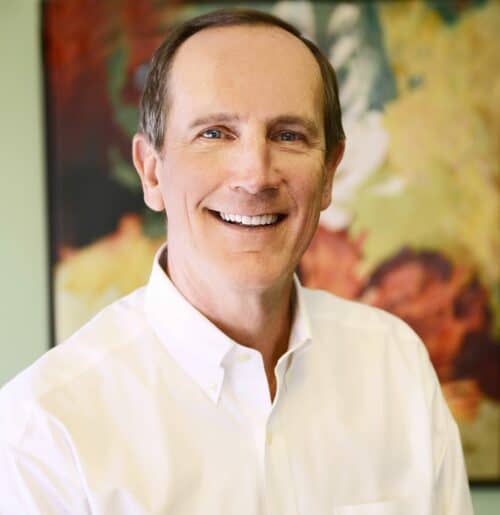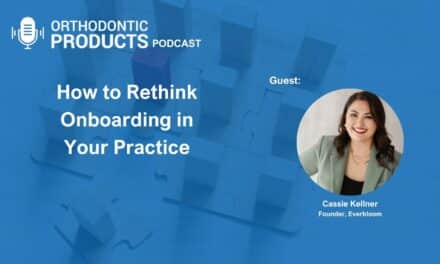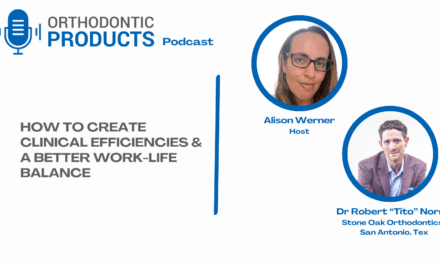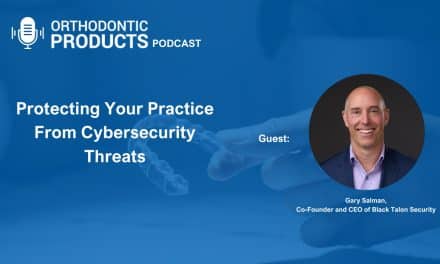Michael Mayhew, DDS, MS, a dual-trained orthodontist and pediatric dentist in private practice in Boone, NC, shares how his bonding workflow has evolved over the course of his career and how the new Ormco Digital Bonding workflow takes it to the next level. In this podcast episode, hosted by Orthodontic Products Chief Editor Alison Werner, and sponsored by Ormco, Mayhew talks about how the new workflow not only meets the needs of his technology forward practice but also provides the missing piece to complete his digital workflow.
To start off, Mayhew introduces his practice and his trajectory from pediatric dentist to orthodontist. His extensive experience in the field sets the stage for a deep dive into the world of bonding, revealing a career marked by evolution and innovation.
Mayhew’s candid account of his experience with bonding over the years highlights the critical turning point he faced as his practice expanded. Seeking increased efficiency and delegated procedures, he embarked on a journey that ultimately led to Ormco Digital Bonding. He explains that the technology has been in the making for over two decades and how it aligns with the Damon Ultima bracket system and Spark Clear Aligners.
As the conversation unfolds, Mayhew discusses his practice’s tech-forward approach. His endorsement of cutting-edge technology is pivotal to understanding the significance of Ormco Digital Bonding for him.
The discussion then pivots to a deep dive into Ormco Digital Bonding. Mayhew reveals how it leverages Damon Ultima brackets, the Spark Aligner Approver software platform, and Ormco jig technology.
Mayhew provides an explanation for how the Spark software fits into the bracket positioning workflow and shares his personal experiences working with it. He elaborates on the strengths of the 3D-printed, soft-material jigs and how they enhance bracket placement. The technology, he notes, is adaptable and efficient, ensuring a secure and precise fit. Moreover, he talks case progression, and explains how he is seeing fewer wire repositionings and minimal debonds which bring greater efficiency to the practice.
The discussion also touches on the potential of Ormco Digital Bonding for hybrid cases, presenting it as a solution to complex treatment planning.
The interview takes a turn towards practice management and efficiency, with Mayhew pointing out that this type of workflow can free up chair time in the orthodontic practice.
Mayhew offers his advice for those new to the technology and planning to implement it. He emphasizes the need to focus on staff training and support. He underscores the need to align the entire team with the implementation process, emphasizing the technology’s potential to enhance the patient experience and streamline practice operations.
In conclusion, Mayhew talks about the marketing power of embracing digital workflows in orthodontics and how it can resonate with tech-savvy patients and parents. He expresses optimism for the future of orthodontics, foreseeing shorter treatment times and increased patient satisfaction with technologies like this. OP

Podcast Transcript
Alison Werner 0:10
Hello and welcome to the orthodontic products podcast. I’m your host Alison Werner. On this episode sponsored by Ormco. We have with us Dr. Michael Mayhew, and orthodontist in private practice in Boone, North Carolina. He’s here to talk about the launch of Ormco digital bonding and how how it has impacted his treatment planning workflow, his cases and his practice. Here’s our conversation. Dr. Mayhew, thanks for joining me.
Dr Michael Mayhew 0:32
Thank you for having me. To start,
Alison Werner 0:34
can you tell me a little about your practice and kind of the course of your career?
Dr Michael Mayhew 0:38
Well, I am a dual trained pediatric dentist and orthodontist and started doing all this myself. And over the years, we added pediatric dentists and other orthodontists. And fortunately, we’re able to build a great practice in a small rural area in Northwest North Carolina.
Alison Werner 1:00
Great. Well, we’re going to be focusing in on bonding today. So I’m kind of curious to get your experience with bonding over kind of the last the course of your career, what is your experience been?
Dr Michael Mayhew 1:11
Yes. So I found that as our practices growing my time chairside was in high demand, and I was trying to evaluate a way that we could increase our practice efficiency, add procedures that were more delegated able to staff, and through utilization of some consultation with practice advisors, and consultants, we started looking at the concept of indirect bonding. And at that time, it was more of a process that utilize our what we would call in house indirect bonding or process that we utilize more of our staff. But we found that that bog things down quite a bit. And that soon led to me working with other companies in a digital process and around 2003, 2004. So something we’ve been doing for over 20 years.
Alison Werner 2:11
I’m curious, overall, would you describe your practice as kind of digital or technology forward?
Dr Michael Mayhew 2:18
Very much so I can know some of that to son who is in the networking business and in the orthodontic networking system in orthodontic practices, I would see something or be intrigued by something that was starting to arise in the orthodontic industry. And I could share that with him. And he could be more insightful to me about where this could go in my orthodontic practice. So very, very interested in the high technology. We had one of the intraoral scanners, one of the first intraoral scanners, we’ve had CBCT, in our practice for over 15 years, just very forward thinking and all the technology that we can utilize in our practice.
Alison Werner 3:05
Well, the reason I asked that question is because we’re going to talk about Ormco digital bonding. And that is, you know, leveraging the latest technology, and we talking about your history with bonding. So the goal of this system is to improve bracket positioning and streamline that practice workflow. So the system is leveraging the company’s Damon Ultima bracket brackets, the Spark software platform, which will be familiar to Spark clear aligner users and Ormco jig technology. Now that’s the official description of what Ormco digital bonding is. Can you tell me in your words, what is it for you in practice?
Dr Michael Mayhew 3:38
Right? Well, let’s step back a little bit. And I have been utilizing the Damon orthodontic appliance, basically since it hit the market. But we knew there were issues with the passive self ligation bracket. We knew it helped us a great deal early on in treatment because we had a large lumen where the wires set within the bracket. But as we progress with treatment, the finishing slowed us down, we had a lot of play in the wire bracket interface, that sometimes we would not be able to optimize the alignment that we’d like to get. The last few years Dr. Damon has worked on eliminating that play within the bracket. And so now there’s a greater premium on placement of the orthodontic bracket, particularly the Damon Ultima. So we’ve learned that if we can, it was designed, first of all to be at that FA point or the center of the tooth along the long axis. Well, that may be easy for some people to find it could be challenging during the daily workflow of practice if you’re rushing and moving along quickly to achieve that optimal bracket positioning. So now that increase my interest with Ormco instating we knew we had a bracket that needed to be placed optimally to maximize its benefits, and we had a Spark Aligner software platform that we could possibly use to help us place those brackets. And that to that marriage between the Spark Aligner platform and the Damon Ultima bracket led us to creating the Ormco digital bonding system that we have today.
Alison Werner 5:24
Okay, so talk to me about what stands out to you when using that software when you’re planning the bonding.
Dr Michael Mayhew 5:32
Right? Well, first of all, the Spark approval platform, I believe it has been shown by many orthodontist to be much simpler, at least it has, in my opinion, for our practice, than other leading softwares that we’ve used for aligner systems. And so it’s a simple system. And basically, a lot of orthodontists are obviously are already accustomed to approving aligners approving the setup that they received from the technicians. And so this software for our fixed appliance system determines the FA point or the optimal location that the the Ultima bracket should be positioned. And so when we get the approvers cases back to be approved, there, it’s much simpler process. And being aware of how the software works, and the simplicity that the technicians allow us to do by doing a great job of positioning those brackets, there’s a lot less time involved for the orthodontist. So we have a single platform that you’re able to submit both aligner cases and indirect bonding cases to Ormco. The technicians follow your design of the for the case, and there’s a short latent period where they’re working on that process before it gets back to you. And a much more efficient approval aspect. And you’re able to visualize with the bracket brackets, all the brackets in the optimal positions where those teeth would end up.
Alison Werner 7:04
And then once you’ve submitted your plan, how long does it take to get the jig back from Ormco
Dr Michael Mayhew 7:13
Ormco’s goal is to be able to provide the jigs the delivery system delivery carrier system within a seven to 10 day work period. Of course, that would be dependent on how quickly the doctor gets to the case to do the approval.
Alison Werner 7:32
So talk to me about the the jig technology, which this indirect bonding relies on what stands out to you about that carrier design at the jig
Dr Michael Mayhew 7:42
Correct. One of the indirect bonding systems that Ormco had in the past was Insignia that had a mailed carrier delivery system. And sometimes that would not fit as optimally as you’d like. Our current system is 3D printed. And it’s a softer material, if you will. And it is designed with receivers that allow the brackets to be seated firmly within the carrier system. And the the ability to place those onto the teeth. There is a cap that actually extends both buccally and lingual that gets a very, very stable result for you. Plus, if you do have one, we always recommend placing that initially in a dry state, just to check the fit. And if there’s a rocking point, or perhaps a tooth has erupted a little bit more over a week or so time period, then you can use scissors to just cut that particular bracket carrier off and do it individually. So there’s an x a is very versatile, it fits awesome. And one of the as you’re doing the bonding process, there is not a custom base or using composite on the bracket base as most people would be accustomed to doing with a direct bond. And as you seat the jig as I said it seats very well. It provides three surfaces that you can go around and clean any flash, any extra glue that may extrude the front placement of the jig, and then it’s readily light. It’s a great process.
Alison Werner 9:24
What has your staffs’ experience been with the bond because I imagine they’re doing much of this.
Dr Michael Mayhew 9:30
They are. That was that’s one of the great benefits and that’s what got me so interested in it. You know, as an orthodontist, I was creating the treatment plan creating the tooth movement digitally. And so once we’ve approved that, we’re going to get what we approved. That’s what we have noticed during our clinical trials during the Ormco digital bonding process clinical trials. My staff was accustomed to doing full tray bonding systems, and you just bond them on, you can’t see really what you’re doing very well. And then as you take them off, you see what how successful you were, with this process. They didn’t know, initially, it took a little more time, because they were probably more careful with it. And they it was a new process. But I just told them, you know, if it’s a little more time now, it’s gonna save us time later clinically, because we anticipate fewer repositionings and fewer wire bends and finishing the case. But the staff love the concept of doing the indirect bonding, they feel more involved in particular cases, it makes them more proud of the accomplishments they can achieve in their jobs.
Alison Werner 10:43
Well, my next question was going to be how have you seen cases progress with this new indirect bonding? And you talked a little bit there about how you’ve had fewer wire repositioning things? And I imagine the debonds have or not, you know, such such a problem. But can you talk a little bit more about how it’s actually impacting cases and what you’ve noticed?
Dr Michael Mayhew 11:03
Sure. You mentioned debonds. And one of the first questions that I get from orthodontist is are the brackets staying on. And typically, we’ve seen a few debonds, very few, I should say debonds once we removed the the carrier jigs system at the initial bonding. And we may see some trauma points where maybe they’re biting down on brackets, and we try to protect those areas. But we’ve not seen high level of bonding failures. And typically, for my opinion, in my opinion, if we don’t say something happened within the first month, then that means it’s maybe more abuse as then to the bracket system, then then the bonding process itself, we have, we initially tried this with the Damon Q2 appliance and tested it out before we started using it with the Ultima. But the Ultima cases that we have finished today, we’re averaging, maybe one or two repositioning, and very few wire bends, if we do wire bends are typically more so in the posterior, because in the Damon Ultima system, those brackets are more passive in those particular areas. So it’s greatly improved our clinical flow of treating those patients.
Alison Werner 12:22
How has this workflow streamlined kind of your office from a practice management perspective? What efficiencies have you seen there?
Dr Michael Mayhew 12:31
So the biggest efficiency is that the doctor does not have to be chairside. For the bonding. Yeah, there’s different states and different laws that talk about whether something as delegated will like this, and each orthodontist would know their own specific concept there. But it’s just freed us up for the 15 minutes or so that we would normally sit chairside. And we’re able to implement other procedures where the doctor is more perhaps more valuable to be used chairside instead of placing brackets where we can digitally design the case, and have the staff be able to place the brackets for us.
Alison Werner 13:09
Since this this platform or this workflow does utilize that spark software. Are you treating any hybrid cases? And if so how does the ability to work within one software platform impact that treatment planning and the course of treatment?
Dr Michael Mayhew 13:25
Well, that’s that’s a great question because there is a lot more discussion on hybrid treating cases. And I have done hybrid cases at this point in time, not with the Ormco digital bonding concept. It is on the way, though, is one of the future things that we want to incorporate that in. But there are aligner cases that we recognize some of the challenges we may have using aligners, not just will the patient wear them, but are the aligners most or more efficient in treating treating certain cases better than others. Whereas are there fixed appliances that are more efficient in treating certain things. What I have found over the last several years, and this has been something we’ve done independent of the Ormco digital bonding process is a lot of maxillary aligners, and at the same time placing fix appliances or braces on the lower either to finish the entire case that way, or in very challenging malalignment cases to utilize fixed appliances first, and then finish that patient with Spark Aligners. And so being able to streamline these two concepts together will really be a workplace positive once Ormco gets that final aspect of the Ormco digital bonding together.
Alison Werner 14:51
If you had to talk to someone who is looking at integrating this for the first time and maybe doesn’t have a lot of experience with indirect bonding what What would your advice be to them?
Dr Michael Mayhew 15:02
I’ve talked about this just recently in a conference that Ormco had in Chicago. Number one, you do need to get your staff on board. And that means proper training, not just hand them something, it’s like, go do it. And the orthodontist or the management team needs to be on board with the full support. Ormco plans and has in their in their plans for the regional or the area representatives to work with each office and helping to implement. But the training process itself, as I mentioned before, you’re already accustomed to using the Spark Aligner system, hopefully, and so all you’re doing is working with a digital treatment concept of fixed appliances within that same platform. And then staff are typically already used to or accustomed to preparing the mouth for either direct bonding or indirect bonding, whichever case you’re using, and you’re going to find that they will accept the Ormco digital bonding carrier jigs much better than any other system they’ve used before. So it’s just a matter of training, and being supportive to the staff, that this process can be a much improved technique for them.
Alison Werner 16:22
What does it mean to you overall, to have this aspect of your clinical workflow be digital?
Dr Michael Mayhew 16:29
Well, I guess number one thing that parents and patients see is a huge marketing concept that they see this as just high technological systems that we utilize in practice. In our practice, you know, we have intraoral scanners, we have the CBCT X rays, your computerized patient management system, they patients and parents see this as a huge streamline in your treatment options. And when they can visualize the end in mind when you’re showing them the setups with the teeth already aligned, and we do that we’d like to be interactive chairside, showing the parents what we can do and what we’ve done to plan for their treatment, it’s a big win in terms of the technology that they perceive that we’re involved in.
Alison Werner 17:19
Well, my final question is what excites you about the future of orthodontics?
Dr Michael Mayhew 17:24
Wow. Well, number one, I don’t think they’re gonna get rid of us. I hope not. We’re just working. I remember Ormco, several years ago, did a study, particularly for adults that if we could do treatment within a 12 month period of time, they would do anything that to be able to accomplish that, within that timeframe. What I have found in being able to be more efficient, not only with the digital bonding, but also with the Damon system, our cases are treating out more efficiently, faster than what patients had anticipated. They always think they’re going to be, particularly parents were in treatment, maybe two and a half or three years. That was my experience being treated. And now we’re able to treat people and 14, 16, 18 months depending on the you know, the difficulty of the case. So I think that if patients know that they can be treated correctly and properly, but more efficiently due to the technologies that we have. I think that’s going to be a huge boon to the practice and specialty of orthodontics. All right.
Alison Werner 18:37
Well, Dr. Mayhew, thank you so much for joining me today. And I really appreciate you offering your insight into Armco digital bonding.
Dr Michael Mayhew 18:43
Well, I appreciate you having me and it’s it’s an exciting field and something that even though I’ve practiced many, many years, I’m still very excited that being a part of it. It’s fun.
Alison Werner 18:53
Great. Well, thank you.
Dr Michael Mayhew 18:55
Thank you.
Alison Werner 18:55
As always, thank you for joining us. Be sure to subscribe to the orthodontic products podcast to keep up with the latest episodes. And be sure to check out orthodontic products online.com to keep up with the latest industry news. Until next time, take care.













